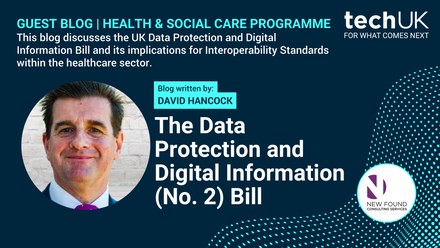NHSX publish What Good Looks Like framework
Earlier this week NHSX published the highly anticipated What Good Looks Like (WGLL) framework, aiming to draw on local learning from the pandemic and build on good practice to provide guidance for health and care leaders undertaking digital transformation. The framework looks at how to ensure success across an Integrated Care System (ICS), providing a new assessment framework to measure digital maturity and identify where improvement is needed, as well as funding and access to digital expertise.
Sonia Patel, chief information officer at NHSX, said: “We want to ensure that we have ubiquitous digital and data transformation capability across the country and without a standard, we are likely to inherit lots of variation.
“The repercussions of variation could be at the consequence of delivering better patient care and better outcomes for the population, so therefore it is really important to provide a clear north star.”[i]
As techUK’s Health and Social Care Council heard from Sonia earlier in the year, the core purpose of WGLL is to provide a set of tools and guidelines for NHS leaders to enable them to lead meaningful digital transformation with confidence, providing opportunities for the NHS to collaborate better with itself and with providers.
The WGLL framework provides seven success measures for Integrated Care Systems, and for individual organisations. The success measures for ICSs are as follows:
- Well led
This measure looks at how Integrated Care Boards can build digital expertise and accountability into their leadership via the implementation of an ICS-wide digital and data strategy. This strategy should look to drive ‘levelling up’ across the area, identifying digital solutions for improving health and care outcomes by working with partners and citizens, and invest in improving the digital competence of the board.
- Ensure smart foundations
The framework states that ensuring ICSs have the requisite foundations to deliver modern digital and data services will entail a system-wide strategy for building multidisciplinary teams that can deliver these ambitions, driving towards a simplified infrastructure by consolidating spending, strategies and contracts, and working towards wider use of electronic care record systems and the development of an ICS-wide shared care record.
- Safe practice
NHSX outline that the standards set out in the Digital Technology Assessment Criteria (DTAC) should be maintained, as well as proper management of cyber risk and security.
- Support people
ICSs should ensure their workforce has a high level of digital literacy to facilitate a digital-first approach, as well as to allow the movement of staff across the ICS and encourage staff to share innovative ideas. The framework refers to the importance of a shared care record for enabling front-line staff to do their job efficiently.
- Empower citizens
The framework highlights that citizens should be placed at the centre of service design and have access to a set of digital services that suit all needs as well as their own healthcare information, encouraging them to take an active role in their health. To achieve this, ICSs should develop both a strategy for citizen engagement that is co-designed with citizens, and a specific digital inclusion strategy which aims to better serve digitally disempowered communities.
- Improve care
Through redesigning care pathways and employing decision-support tools, remote consultations, monitoring and care services, ICSs should lead a system-wide approach to improving care via digital and data solutions.
- Healthy populations
Finally, the framework outlines that ICSs should use insights from data to enable population segmentation, risk stratification and population health management. Data should be used to redesign pathways and focus on prevention, as well as coordinating across different care settings. Data should also be made available to support clinical trials, real-world evidencing and AI tool development.
This framework will act as the new digital maturity assessment for the NHS, and there are plans to develop a similar framework for the care sector later this year. Unlike the previous assessment, this framework aims to assess the surrounding culture at an ICS, including the people, skills and processes needed for successful digital transformation. Additionally, NHSX have shifted the assessment from self to peer-review to ensure a greater level of subjectivity.
Alongside WGLL, NHSX published a proposal ‘Who Pays for What’, looking at solutions to current barriers to investing in digital technology. The proposal includes consolidating national funding for transformational tech projects into a single fund across 2021 and 2022, known as the Unified Tech Fund. This will be followed by greater control for ICSs over resources to deliver tech plans, taking place over 2022 to 2023. NHSX are keen to receive feedback on the current Who Pays for What proposals.
Following techUK’s recent event with NHSX looking at Frontline Digitisation, upcoming events in 2021 with will explore WGLL and future plans for digital transformation.












